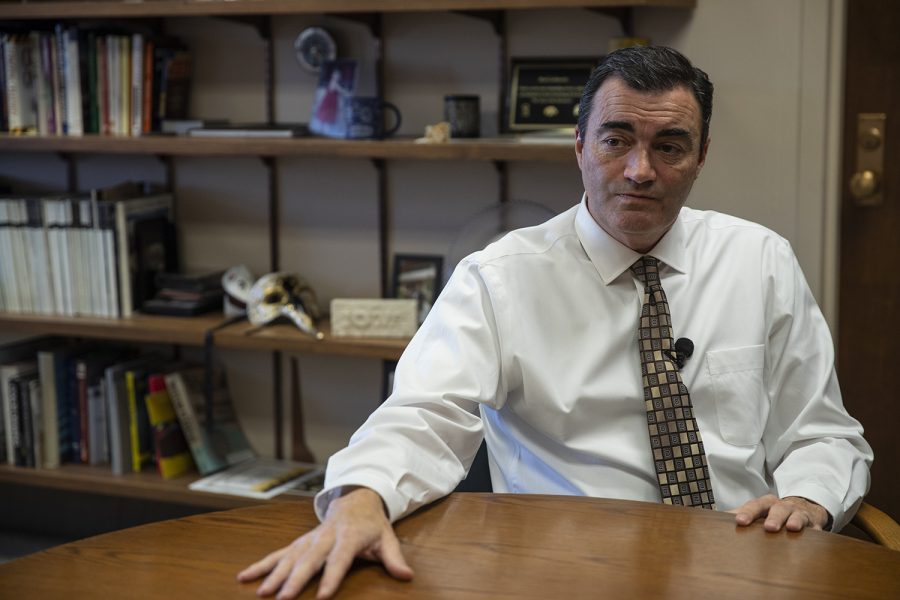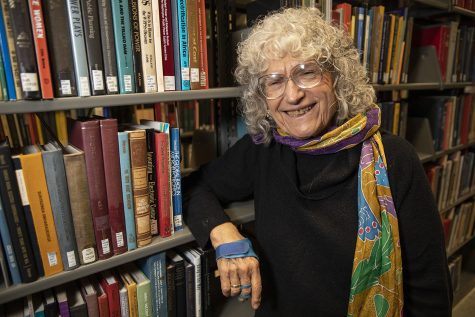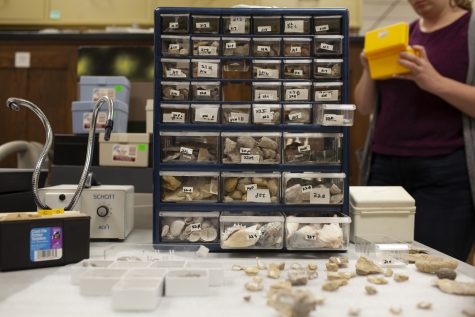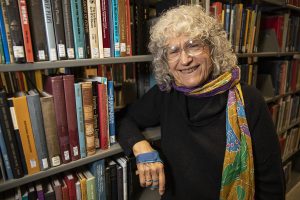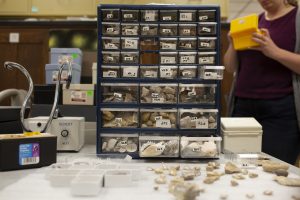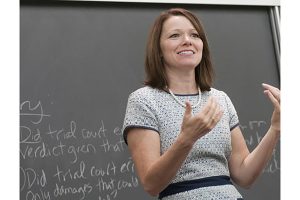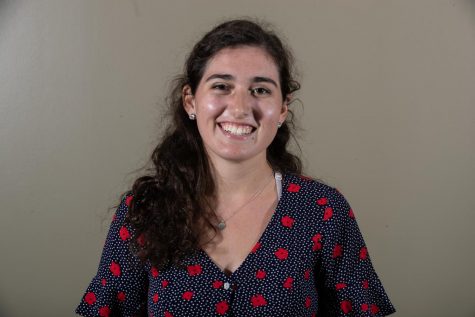Q&A: Senior Vice President of Finance and Operations talks climate strike, P3, Finkbine development
In an interview with the Daily Iowan, Senior Vice President of UI Finance and Operations Rod Lehnertz spoke about local climate strikers, a potential public/private partnership at the UI, and the Finkbine development.
Director of Finance and Operation Rob Lehnertz sits down for an interview with The Daily Iowan in Jessup Hall on Tuesday, Oct. 15, 2019.
October 21, 2019
DI: If you had something to start with, feel free.
Lehnertz: Yeah, so, I guess I’ll start with this, in asking this question, about the timing of this — will it be this week? The reason is, I’m just wondering, it’s Homecoming week, and so I was going to start a little bit with that, and it may be some of the things that are going on tied to, even sustainability and others, but it will sound a little odd if I’m talking about Homecoming week if its next week.
DI: We’ll probably run something this week.
Lehnertz: Alright, well, you can patch things together if you want, but what I did want to share- there’s a couple of things. It is Homecoming Week at the University of Iowa. We all love this time of year —the weather’s changing in a great way, and this week we bring not just our students together. We bring alumni back to campus. There’s great energy on campus.
And also a great new tradition, or developing tradition, and I encourage you all, all of us in the university community, to get over to the IMU bridge, the bridge itself built in 1936, crosses the river right at the Iowa Memorial Union. We’ve begun a tradition on Homecoming week, and also graduation week at the end of the academic season in the spring, to fly the flags of representing the nations of all the students on the University of Iowa campus.
We have 107 nations represented on the bridge this week. It is beautiful to look at, and I think, especially this day and age, it means a great deal, and the responses we get from students who are from those nations, seeing their flag, see it as a true welcome, and something that is meaningful to them, and I think meaningful to us.
So I encourage everyone to make that part of their homecoming tradition, because it is an important part of ours, and it’s a new tradition and one starting. In fact, the tradition was started with an idea from President Harreld’s wife Mary. She was the one who came up with the idea, and I think it’s off to a great start.
I think it also helps point us toward attention to the Iowa River. Of course we’re all, and many of our students now may be distant memory or before their memories about this place, the recovery of the flood, but really we’re there. And our campus is different, our campus is recovered, and now what we’re doing in understanding our relationship with the river better is bringing our community and our campus community to the river. And we’re going to be doing more and more things on the river, around the river, to bring people to that special place, and bring attention to the river because there’s been a lot of attention recently about our climate and about sustainability and the important need of that moving forward.
I think a quintessential example of .. our campus … is our river. It is not a clean river. It is one that needs to be cleaned. And if we can bring attention to that river and in the end make that one of the byproducts of our attention on the river, by looking for ways to make it cleaner as a symbol for water waste throughout the state, I think we’ll have something to look back on and be proud of.
I just left a meeting with the University of Iowa gardeners club, and they are working on a fundraising effort to put a new student garden on the banks of the river on the east side of the river by North Hall, and we’re working with them on both the plans to build it, and the plans to care for it and looking for the funds, fundraisers, partners, and others who are interested in gardening. It’s energizing for me, in my position, to have a chance to meet with the students, work with the students, partner with the students. And again this is another example that fits into that changing our world, our planet, our climate, in a positive way along the banks of the Iowa river and bringing people to it.
So, we’re encouraging people to look for that and look for ways to partner with us as we develop a garden. And then one more note on that, something all of us can look forward to, our College of Engineering — our hydraulics institute — won in effect. It’s like an Olympics for water quality bid, and the international water quality conference is being hosted by the University of Iowa this next fall.
And so, as 2020 August comes around, we’re going to welcome nations from all over the world, and some of the greatest experts in water quality and treatment of water throughout the world. We’re going to kick that off with something called the Big Splash, and it’ll be a memorable moment and event that will occur on our campus at Hancher Auditorium, and in other places where we’ll showcase the University of Iowa, our Iowa River and what we have on this campus for all of those nations. I think all of those things wrap into something that is meaningful to all of us and also an exciting time this week and the months to come.
DI: Yeah, so with the local climate strikers speaking up every Friday and with Greta’s recent visit, how has that informed the sustainability conversation on campus?
Lehnertz: Absolutely. Well, as we visited, the importance of protest is something we, on a university campus, speak so often about freedom of speech and freedom of expression and the importance of that — gathering people together for real causes and generating the energy in the population to get things done is important.
I think as I shared with you when we visited, most who want to get on those fronts of garnering support and action want the circle to be larger, want the group of people pushing for those changes to be larger. We do, too. I think putting our arms around each other and working as partners is the way to enlarge that circle.
While sometimes it’s needed, protests can often end up as fingers pointed in the chest of the other person, and thus we don’t share information, we don’t learn about each other and learn to work together and with respect to the activities that have occurred in Iowa City. And with Iowa City and on our campus, they do push us in good ways, and we do want to partner. We have now established a kick-off meeting for our next iterations of sustainability on this campus.
I will say, stepping back, we’re very proud of what we’ve done on this campus. Our utilities and energy management teams, for years, have been at the forefront of universities looking to explore the possibilities and viabilities of biofuels and to minimize the impacts of coal in our producing steam for not only the campus, but for the University of Iowa’s hospitals, which is a lifesaving, life mattering issue.
A little over three years ago, because of the work done by our folks in our utilities and energy management organization, we had pushed biofuels to a point where they came to central administration and said we’re ready to put a target on ending coal on this campus at 2025, and that’s when President Harreld announced that. We had the student community, the sustainability leaders on this campus academically and with students with us on the stage as that was announced and it was an all positive that is something we are very proud of, and we are still pushing every day to push that date forward and make it happen earlier.
There are real issues that keep you from just turning a switch and making that happen, but we continue to work toward and test ways to maximize biofuels, and we are doing what we can do to make even 2025 a date that’s further away than what will be for the end of coal on our campus.
That being said, there are many other things. That’s not the only thing we do. I mentioned the river and about what we should try and do as a community and as a state to improve the quality of the waterways in Iowa and certainly the Iowa River here in Iowa City, Coralville, and the University of Iowa.
We are gathering at the end of this month the sustainability leaders on our campus, campus sustainability committees, faculty that are forerunners on that front, students that are dedicated to that. I visited with a group of students the day after the downtown protest, and we had a wonderful conversation and that has spurred my inviting them and other leaders, student government leaders, and faculty leaders to start a series of teams that will identify those things that in the student government referendum are highlighted, plus others that we can do to make sure that we remain a model for universities on the sustainability front.
So, I would expect over the next course of weeks and months we’ll be working as a group of teams, going out and working, building a wider base, and having more and more people involved in how we define what sustainability will be for our campus and people.
DI: And have there been any conversations with like the regents or with any state officials to push for more sustainability?
Lehnertz: Well, we want to make sure that we take care of our ship first, that we do what we can do on our campus to control where we’re headed on our campus and serve as a symbol for others to follow, not just in Iowa, other places.
But with respect to the Iowa River, there are a lot of waterways in our state and some challenged and some not from an ecological perspective. What we can do to help clean the Iowa River, make it better, I think will serve as an example for others in the state.
We know that for instance, one of the biofuels, our utilities and energy management team has advanced in an innovative way is the pelletizing use of … an effect of a big weed that grows about 12 feet tall every year, [sort of] like bamboo, and can be regrown each year and then burned once its pelletized. Those grow in farmland, and they are a low risk crop because you don’t need to put insecticides on them. They are not temperature sensitive, and so they turn into a viable option for us to work with local farmers to farm that.
It’s also an option, I believe in the future, to look at protecting waterways, where we are able to possibly plant those closer to streams and rivers so that the runoff is minimized, and then the byproduct becomes a biofuel eligible material. Working with one of our representatives Kevin Kinney, who is a farmer as well, has been very interested in what the options may be as we look forward to scan working with farmers.
We are already working with farmers and look to work with more farmers in that front. I think those are the beginnings of options for us to work in partnership with our state, and with our agricultural professionals and our farmers in the state, to do right by our farmers and by our planet.
DI: There was a recent GPSG meeting and they were talking about the P3 and how some of the bidders were interested in getting the UI off of coal by 2023, so do you think that early is realistic?
Lehnertz: Yeah, yeah, I do. What we do know is this: that we are working with and establishing the finalist for the in process of utilities P3. We’re working with the world’s leaders in the energy sector.
One of our finalists said, “The only reason we are considering you as a potential partner is because you’ve promised to go off of coal. We don’t deal with organizations or entities that are on coal.” All of them have said that the first thing they want to do is explore our plans for 2025, and how we can expedite that.
So yes, I believe, and that’s not just with their help, our utilities and energy management group is currently working to shorten that timeline. And I think the partnership in what we will have in our P3 effort, and again we’ve not received the bids yet, so I can’t say its fate to complete. It is certainly something that is well in progress and has gone well to date.
The finalists we are working with our leaders in that front, and I think there is a great deal of promise for them to continue pushing, working with, and partnering with the University in ways that will help us from that green perspective as it goes with steam generation and enabling the operations of the university.
DI: And should the UI proceed with the P3? What would be the next steps the public would see?
Lehnertz: Sure! Absolutely, So we are within a month of receiving the bids, and there’s a relatively short period of time, probably by the middle of November, we’ll have a top selected partner established. We’ll spend over the next month refining what will be the concession agreement for the program and then we’ll garner Board of Regents, university approval for that, as with the vendor as well in probably the middle of December.
Then, we’ll move forward with what we call a commercial close. And we would then move forward in our working with the selected vendor, at that point, assuming the bids are such that we select a vendor.
It will depend upon our work and their work, but we are anticipating sometime within the month of January we will have financial close, and we would be bringing on the partner immediately.
DI: I guess what does it mean to bring the person on immediately, because I know the whole thing with resources wouldn’t be used until the beginning of the next fiscal year?
Lehnertz: Yeah, so a couple things on that front. One, they will in effect adopt the staff of the utilities and energy management organization. Part of that month after selection is for that selected vendor to come on campus and to get to know the employees, to talk with the employees, find out what they are thinking about their future career objectives, and then assimilating them into their culture and their company, and then they would begin working for them upon our close of this deal.
We will see no hiccup on our campus, because they’re still our great people that have developed this entire utility system in the way that it has been so effective. Then they will be working for a new employee, but on our campus.
We will garner the funds and will endow the funds from this arrangement but are going to make sure that we are carefully investing those in a series of, if you will, on campus initiative grants, non-recurring funds as sort of a one to five year period of time to allow for seed money for great initiatives that will advance student success, performance of our students success in research, and discovery to things that will make a difference to our campus.
But, we want to establish the endowment and establish the funds and not pay ahead of those dividends coming in. So, we’re going to be as we need to be on behalf of this campus. We’re going to be judicious and conservative in our approach and make sure that risks are minimized. We’ve got the university’s long-term viability and success in mind with every step we take, and that doesn’t mean acting fast. It means doing the right thing.
DI: And would the terms of that concession agreement be made public or how would that be communicated?
Lehnertz: Yeah, so, through our process, we’re in the middle of the process now, so as we finish, there will be the facts of the RFP and what we’ve done and the process will certainly be something that we share.
DI: Would utility prices be affected at all?
Lehnertz: Well, one of the things to note, in our working carefully through this process over the last year and listening to what others have done and listening to our experts, understanding the business from the vendors perspective, the concessionaire’s perspective.
We have decided that fuel procurement will remain with the University of Iowa. So, whether it was the concessionaire or us doing that, world wide fluctuations in utility prices are inured either way, but we know that we can work and control and prognosticate those fuel prices, keep them local.. and how they will allow us to have a diverse mix of fuels that we are purchasing, and those fuel prices are not things we set, but that is something we are going to address as a campus moving forward.
DI: President Harreld said at his State of the University address last week that more P3’s are possible?
Lehnertz: Well, what we know that higher education in the state and throughout the country is challenged with less funds and tight budgets. And our governor invited us and really kicked off this whole process.
Gov. Kim Reynolds invited the university, the regents institutions to look for new ways to partner, to do business, to garner important funds that are needed for the universities to succeed on behalf of our students and our state and look for ways we can garner revenue that allow us to accomplish our strategic plan.
And so this effort is a notable one that everyone is watching it take place as it does in higher education. For instance, there are other examples of public-private partnership that work well in their environments. Every environment is different, and we will certainly study options in the future.
Nothing has been set in stone to move to a next step, because we are still in the midst of the very first and major one we are doing. But, we take the Governor’s offer and encouragement seriously and will look for ways we can benefit our students, benefit our research and discovery, our objectives in our strategic plan in any business oriented ways or efficient ways that we can, making the bang for the buck of every dollar we have at the university for the success of those who come here.
DI: And this is a bit of a shift, but with the enrollment decline that is anticipated over the next decade or so, how does the campus prepare for that? Does that mean less building space being used?
Lehnertz: It’s a big question. There are sources that indicate that the drop in birth rates in the past will impact enrollment eligible students in the future. There are still questions to whether or not and how Iowa will be specifically affected with that.
What is key regardless of that is we are a university that is worth going to for the residents of the state of Iowa. And I say that because .. other states have challenges they will want to, if you will, come after and recruit Iowans to their universities. We want our students to learn from us.
We encourage a healthy mix of in state and out of state and international students, because it matters to those on campus and to our success as well. It is important that we have a campus that is worth coming to, a university that is worth coming to. The graduates of this university will compete for fruitful jobs from against students that come from those universities that we call our peer universities, and we want our students to be well prepared for fruitful careers.
We also want to make sure we are a place that faculty and students want to come to. And the way that you do that is be as good as you can be in accomplishing your strategic plan, and that’s why when you mention the number of students who come, we believe we are at a right size for our campus, roughly 33,000 students now, has been a good size for the number of residents halls we have, number of police we have, number of busses we have, the number of buildings, classrooms, recreation and others.
Growth, as the president has said, growth for growth’s sake is not a strategy in higher education, and what we strive for instead is excellence. We’re confident that where we are headed, and, you know, we had roughly 5,000 incoming students this year. It’s not our largest class, but it’s still among the handful of largest incoming classes that we’ve had.
So, we’re happy with that number, and what we intend to do is make it well worth students in the future coming here. Not necessarily changing course, becoming a smaller university when you mention the number of buildings on campus. On that front, we want to be an efficient and careful spender of the funds that go to so many things that run this university. So, from a planning perspective and a building perspective, the average age of a building on this campus is just short of 50 years, and we have some 250 buildings on our campus.
We have around 20 buildings that are over 100 years of age. That’s an important factor in heritage, history and notoriety of our campus, but it is also very expensive to take care of older buildings. And we modernize them constantly, even within restrained and constrained funding we work hard to make sure that buildings we have on our campus work well for students today, and for faculty today, and for faculty and students tomorrow.
To that end, our planning measures have really been refined in the last four to five years. We are currently in the process, in fact, of removing roughly 250,000 square feet of outdated, antiquated buildings that do not or cannot serve students today and university community members tomorrow.
An example I’ll give is the psychological and brain sciences building at the east end of our campus at Gilbert and Iowa. We will be finishing that building at the end of this calendar year for the spring semester. It’s roughly a 65,000 square foot building that will modernize research and teaching space and student space for the largest program and the largest college on our campus, a very important program, some 1400 majors in psychology.
This will, for the first time since psychology moved into an empty hospital building in 1930, give them a building designed for what they do. Psychology, at the time as it was called, now psychological and brain sciences, moved into Seashore Hall after our hospitals and clinics moved to the west side of the river in 1928.
Since that time, that program and other programs have been operating out of a building, a wood framed hospital structure built in 1899, and parts of the building have been closed down for years, wings removed.
The construction of the 65,000 square foot building will actually also allow us to remove about 140,000 square feet of very outdated, expensive to care for building space that doesn’t serve the needs of faculty or students. And so, those kinds of strategic moves are important for our future and our future success, but that’s also a bit of a story about how we’re being careful and not just building to build or growing to grow.
We’re making sure that what we do on a physical perspective on this campus is wise and prudent and cost effective, but also beneficial for the next generation.
If you got a few things that you are curious about, I have a few minutes.
DI: I guess the Finkbine development.
Lehnertz: Sure, if you go out west past our main campus, you can see construction activity going on the on the Finkbine golf course. We’re well under way on the construction project for a new clubhouse at the Finkbine golf course. That’s an athletics project.
It is a project that is 100 percent supported by a single donor who gave the money for that which is — we’re fortunate to have generous donors who support our campus in an era when philanthropy and private support of our campus becomes more and more important as we try to make ends meet from a fiscal perspective, and certainly from a development perspective, and so when you have a project like that where a single donor comes forward to say they’ll support that project with their passions involved in it, it’s rewarding.
As that happens, we’re also studying its next door neighbor the former university club sight which the building has been raised, and the site is open and available for developmental work, and we’re working with the third party developer on just planning at this point. Nothing secure, but working with the cities of Iowa City and University Heights because the sight is kind of split between the two, and primarily looking, again, in the spirit, as we’ve said earlier in the Governor’s invitation and encouragement for new and creative ways to garner revenue that can support our campus endeavors and our strategic plan.
We will work with, and not develop ourselves, but work with development there that can make for a better community in that area, have more things to offer the community, but then also garner some resources for the university for land that is the university’s, so that we can plow those funds back into improving the university’s performance.
We’ll continue to work on those options and work with the city as we move forward for development that may include, you know, condos and other things that are in the proximity of the golf course and generate new activity and new energy and vibrancy to that part of the community. It is very close to the University of Iowa Hospitals and Clinics, very close to the campus, and I think a site that can be exciting to develop.



